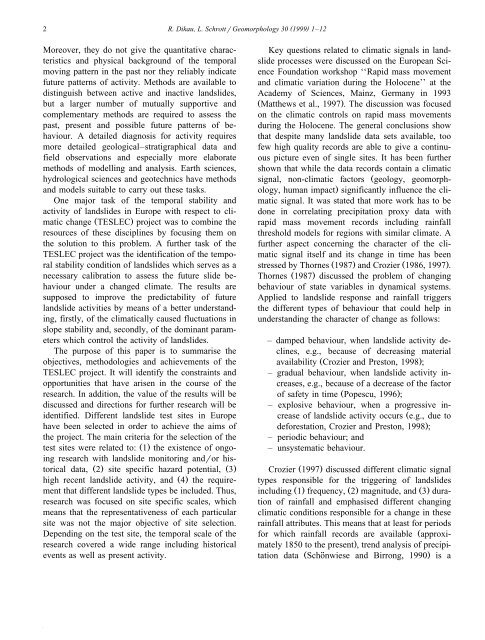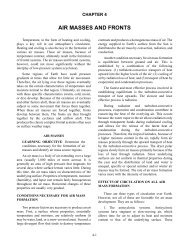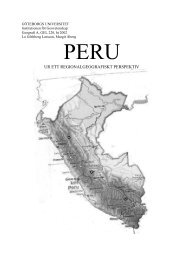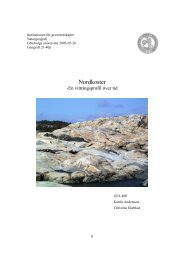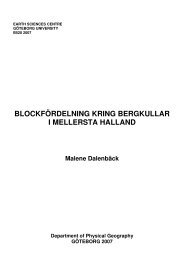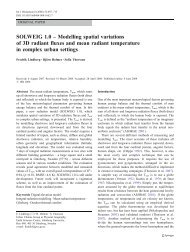The temporal stability and activity of landslides in Europe with ž ...
The temporal stability and activity of landslides in Europe with ž ...
The temporal stability and activity of landslides in Europe with ž ...
You also want an ePaper? Increase the reach of your titles
YUMPU automatically turns print PDFs into web optimized ePapers that Google loves.
2<br />
Moreover, they do not give the quantitative characteristics<br />
<strong>and</strong> physical background <strong>of</strong> the <strong>temporal</strong><br />
mov<strong>in</strong>g pattern <strong>in</strong> the past nor they reliably <strong>in</strong>dicate<br />
future patterns <strong>of</strong> <strong>activity</strong>. Methods are available to<br />
dist<strong>in</strong>guish between active <strong>and</strong> <strong>in</strong>active l<strong>and</strong>slides,<br />
but a larger number <strong>of</strong> mutually supportive <strong>and</strong><br />
complementary methods are required to assess the<br />
past, present <strong>and</strong> possible future patterns <strong>of</strong> behaviour.<br />
A detailed diagnosis for <strong>activity</strong> requires<br />
more detailed geological–stratigraphical data <strong>and</strong><br />
field observations <strong>and</strong> especially more elaborate<br />
methods <strong>of</strong> modell<strong>in</strong>g <strong>and</strong> analysis. Earth sciences,<br />
hydrological sciences <strong>and</strong> geotechnics have methods<br />
<strong>and</strong> models suitable to carry out these tasks.<br />
One major task <strong>of</strong> the <strong>temporal</strong> <strong>stability</strong> <strong>and</strong><br />
<strong>activity</strong> <strong>of</strong> l<strong>and</strong>slides <strong>in</strong> <strong>Europe</strong> <strong>with</strong> respect to climatic<br />
change Ž TESLEC. project was to comb<strong>in</strong>e the<br />
resources <strong>of</strong> these discipl<strong>in</strong>es by focus<strong>in</strong>g them on<br />
the solution to this problem. A further task <strong>of</strong> the<br />
TESLEC project was the identification <strong>of</strong> the <strong>temporal</strong><br />
<strong>stability</strong> condition <strong>of</strong> l<strong>and</strong>slides which serves as a<br />
necessary calibration to assess the future slide behaviour<br />
under a changed climate. <strong>The</strong> results are<br />
supposed to improve the predictability <strong>of</strong> future<br />
l<strong>and</strong>slide activities by means <strong>of</strong> a better underst<strong>and</strong><strong>in</strong>g,<br />
firstly, <strong>of</strong> the climatically caused fluctuations <strong>in</strong><br />
slope <strong>stability</strong> <strong>and</strong>, secondly, <strong>of</strong> the dom<strong>in</strong>ant parameters<br />
which control the <strong>activity</strong> <strong>of</strong> l<strong>and</strong>slides.<br />
<strong>The</strong> purpose <strong>of</strong> this paper is to summarise the<br />
objectives, methodologies <strong>and</strong> achievements <strong>of</strong> the<br />
TESLEC project. It will identify the constra<strong>in</strong>ts <strong>and</strong><br />
opportunities that have arisen <strong>in</strong> the course <strong>of</strong> the<br />
research. In addition, the value <strong>of</strong> the results will be<br />
discussed <strong>and</strong> directions for further research will be<br />
identified. Different l<strong>and</strong>slide test sites <strong>in</strong> <strong>Europe</strong><br />
have been selected <strong>in</strong> order to achieve the aims <strong>of</strong><br />
the project. <strong>The</strong> ma<strong>in</strong> criteria for the selection <strong>of</strong> the<br />
test sites were related to: Ž. 1 the existence <strong>of</strong> ongo<strong>in</strong>g<br />
research <strong>with</strong> l<strong>and</strong>slide monitor<strong>in</strong>g <strong>and</strong>ror historical<br />
data, Ž. 2 site specific hazard potential, Ž. 3<br />
high recent l<strong>and</strong>slide <strong>activity</strong>, <strong>and</strong> Ž. 4 the requirement<br />
that different l<strong>and</strong>slide types be <strong>in</strong>cluded. Thus,<br />
research was focused on site specific scales, which<br />
means that the representativeness <strong>of</strong> each particular<br />
site was not the major objective <strong>of</strong> site selection.<br />
Depend<strong>in</strong>g on the test site, the <strong>temporal</strong> scale <strong>of</strong> the<br />
research covered a wide range <strong>in</strong>clud<strong>in</strong>g historical<br />
events as well as present <strong>activity</strong>.<br />
( )<br />
R. Dikau, L. SchrottrGeomorphology 30 1999 1–12<br />
Key questions related to climatic signals <strong>in</strong> l<strong>and</strong>slide<br />
processes were discussed on the <strong>Europe</strong>an Science<br />
Foundation workshop ‘‘Rapid mass movement<br />
<strong>and</strong> climatic variation dur<strong>in</strong>g the Holocene’’ at the<br />
Academy <strong>of</strong> Sciences, Ma<strong>in</strong>z, Germany <strong>in</strong> 1993<br />
Ž Matthews et al., 1997 . . <strong>The</strong> discussion was focused<br />
on the climatic controls on rapid mass movements<br />
dur<strong>in</strong>g the Holocene. <strong>The</strong> general conclusions show<br />
that despite many l<strong>and</strong>slide data sets available, too<br />
few high quality records are able to give a cont<strong>in</strong>uous<br />
picture even <strong>of</strong> s<strong>in</strong>gle sites. It has been further<br />
shown that while the data records conta<strong>in</strong> a climatic<br />
signal, non-climatic factors Žgeology,<br />
geomorphology,<br />
human impact. significantly <strong>in</strong>fluence the climatic<br />
signal. It was stated that more work has to be<br />
done <strong>in</strong> correlat<strong>in</strong>g precipitation proxy data <strong>with</strong><br />
rapid mass movement records <strong>in</strong>clud<strong>in</strong>g ra<strong>in</strong>fall<br />
threshold models for regions <strong>with</strong> similar climate. A<br />
further aspect concern<strong>in</strong>g the character <strong>of</strong> the climatic<br />
signal itself <strong>and</strong> its change <strong>in</strong> time has been<br />
stressed by Thornes Ž 1987. <strong>and</strong> Crozier Ž 1986, 1997 . .<br />
Thornes Ž 1987. discussed the problem <strong>of</strong> chang<strong>in</strong>g<br />
behaviour <strong>of</strong> state variables <strong>in</strong> dynamical systems.<br />
Applied to l<strong>and</strong>slide response <strong>and</strong> ra<strong>in</strong>fall triggers<br />
the different types <strong>of</strong> behaviour that could help <strong>in</strong><br />
underst<strong>and</strong><strong>in</strong>g the character <strong>of</strong> change as follows:<br />
– damped behaviour, when l<strong>and</strong>slide <strong>activity</strong> decl<strong>in</strong>es,<br />
e.g., because <strong>of</strong> decreas<strong>in</strong>g material<br />
availability Ž Crozier <strong>and</strong> Preston, 1998 . ;<br />
– gradual behaviour, when l<strong>and</strong>slide <strong>activity</strong> <strong>in</strong>creases,<br />
e.g., because <strong>of</strong> a decrease <strong>of</strong> the factor<br />
<strong>of</strong> safety <strong>in</strong> time Ž Popescu, 1996 . ;<br />
– explosive behaviour, when a progressive <strong>in</strong>crease<br />
<strong>of</strong> l<strong>and</strong>slide <strong>activity</strong> occurs Že.g.,<br />
due to<br />
deforestation, Crozier <strong>and</strong> Preston, 1998 . ;<br />
– periodic behaviour; <strong>and</strong><br />
– unsystematic behaviour.<br />
Crozier Ž 1997. discussed different climatic signal<br />
types responsible for the trigger<strong>in</strong>g <strong>of</strong> l<strong>and</strong>slides<br />
<strong>in</strong>clud<strong>in</strong>g Ž. 1 frequency, Ž. 2 magnitude, <strong>and</strong> Ž. 3 duration<br />
<strong>of</strong> ra<strong>in</strong>fall <strong>and</strong> emphasised different chang<strong>in</strong>g<br />
climatic conditions responsible for a change <strong>in</strong> these<br />
ra<strong>in</strong>fall attributes. This means that at least for periods<br />
for which ra<strong>in</strong>fall records are available Žapproxi-<br />
mately 1850 to the present . , trend analysis <strong>of</strong> precipitation<br />
data Ž Schonwiese ¨<br />
<strong>and</strong> Birrong, 1990. is a


